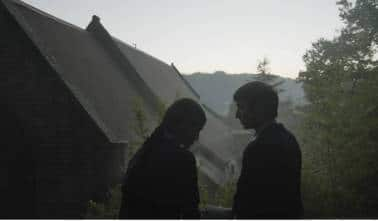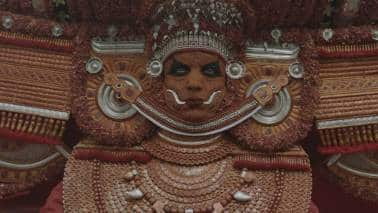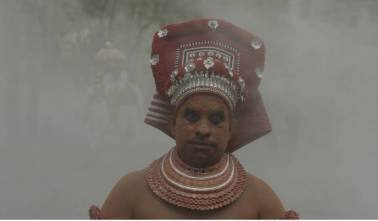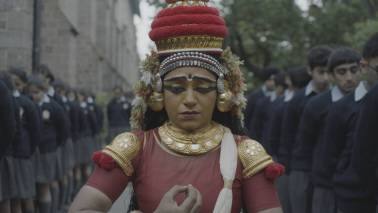



Rahat Mahajan, a debutant director with roots in Himachal Pradesh's Nurpur and a second chance at life in Kerala, is a tragic figure even before his film, Meghdoot (The Cloud Messenger), could reach the masses at home. Earlier this January, when his film represented India at the prestigious Tiger Award competition at the International Film Festival of Rotterdam (IFFR), COVID-19 deprived it of a physical screening. IFFR held a physical screening recently, and the film played sandwiched between packed houses at BFI London Film Festival and forthcoming screenings at Mostra (Sao Paulo International Film Festival) and more.
Closer home, much before protagonists Shiva, Ranbir Kapoor's in the Hindi film Brahmāstra: Part One – Shiva and Rishab Shetty's in the Kannada movie Kantara, would be awakened to their divine power, potential and purpose, Mahajan coalesced, with immense grace, gravitas and stillness, the tussle between the human and divine/other-worldly forces, reimagined in a boarding-school romance.
 Ritvik Tyagi and Ahalya Shetty in a film still
Ritvik Tyagi and Ahalya Shetty in a film still
Mahajan's tragedy is the tragedy of an independent filmmaker in a country consumed by commercial cinema, with few platforms (save, maybe, MUBI or a festival) for indies to reach audiences in time. Before he could bring his spectacle to us, Shetty’s film stole the thunder. It’s time that folk practices appeared in mainstream cinema, but, now, whenever Meghdoot arrives in theatres here, the audiences would already have a visual reference point in Kantara, even though the latter was a later creation. Its shooting began after August 2021, while the former has been 12 years in the making, began its production in 2018, and its visuals all over the news for a while. Coincidence, perhaps, but the novelty is gone.
 Theyyam blends organically into the narrative
Theyyam blends organically into the narrative
This kind of organic infusing of a visual grammar to drive the narrative has rarely been seen in Indian cinema until now. If Kantara draws on Tulu Nadu’s folk ritual of Bhoota Kola, Mahajan blends modern form of storytelling (cinema) with its ancient form — theatre (Koodiyattam by Kapila Venu, Kathakali exponents Peesappilly Rajeevan's Dashananan and Sadanand Bhasi’s Hanuman, and Theyyam by KN Lakshmanan). Making time aside, the film took Mahajan a lot of learning from his time as Vishal Bhardwaj's director’s assistant (Kaminey, 2009; the un-realised docu-drama Julia) and a near-death experience. The now-dreadlocked Mahajan had drowned for 45 minutes in Kerala in 2011. Rescued, with a new consciousness, from death, Mahajan stopped combing his hair since and wrote drowning into the film. What he should take heart in is in the fact that his first feature is philosophical and spiritual, it is experiential cinema/storytelling and not a high-on-adrenaline/decibel socio-religio-political agenda-based “message” film.
Meghdoot is malleable and organic, it affords tragedy to young love, and is about hope and transformation. A 16-year-old boy Jaivardhana/JV (Ritvik Tyagi, with a compelling act and screen presence) is smitten by his new classmate, Tarini (Ahalya Shetty), but there are greater forces at play between them. The story begins centuries before the film does. The eponymous title evinces Kalidasa’s fifth-century Sanskrit epic poem. In which, a yaksha (benevolent nature-spirit) was banished from Kuber’s (god of wealth’s) kingdom. In exile, he persuades a passing cloud to carry his message to his wife on the Himalayan mount in Alaka.
 Director Rahat Mahajan (right) plays the yaksha Jaivardhana
Director Rahat Mahajan (right) plays the yaksha Jaivardhana
The yaksha Jaivardhana is played by the director himself in Mahajan’s reimagining, which begins in the ancient past — my gripe with the filmmaker. After that apriori backstory, I half expect what’s to follow, a reincarnation story about an unfinished task. But had he begun in medias res, the audiences wouldn’t have found the film accessible, which it is. Jaivardhana and Tarini are entwined in an eternal curse — life after life, they shall meet to not meet. Mahajan's atypical and unsuspecting young free-will-less hero JV is chained since the beginning of time, predestined to break a curse. An inward turmoil brewing beneath the outward restraint. He's neither god nor demigod, has no astra (superpower) at his disposal but himself, nor is he a saviour of a clan. No loud shrieks, jangly music, or clumsy writing here — Mahajan, unlike Ayan Mukerji, has followed Hitchcock's advice of a film's three vital elements: “the script, the script, the script”.
The film — with dialogues in English — may not be perfect, but it’s authentic. It is a saturated cloud that signals the unutterable. Like Gustav Holst’s orchestral tribute to the OG Kalidasa poem — and much like its Phoenix-like hero in love — Meghdoot rises to instill hope, to never give up even if death do love part. Tragic young love has come to us in films, from Qayamat Se Qayamat Tak (1988) to Sairat (2016), Mahajan adds the surreal, shows what janmo-janmo ka saath entails, and upends the gender lens of the Hindu myth of Savitri and Satyavan.
 Raj Zutshi in a still from the film
Raj Zutshi in a still from the film
From QSQT also comes Raj Zutshi — who has aged fine as wine — as the benevolent, enabling doot/seer of a photography teacher, modelled on Mahajan’s math teacher Mr Sapru, who gently nudges the unsullied young to connect with their true selves. If Mahajan takes from Joseph Campbell’s idea of myths being clues to the spiritual potentialities of the human life, his film is an instance of what Roland Barthes had said: “the only way left to escape the alienation of present-day society is to retreat ahead of it” — into the myths, which are neither a lie nor a confession/truths, but an inflexion. Meaning lies in the experience, in the living.
Meghdoot’s adversary, like Minnal Murali’s (2021), is humanised, gets a backstory. Raudra (anger) and karuna (sorrow) in Rajeevan’s Dashananan’s (aka Ravana) — who covets Tarini — arise from the trappings of his situation. The power of the performative far surpasses the spoken. Mahajan marries form with feeling. Everything is by design in the film, from natural elements (clouds, thunder, trees) — clouds signify an imminent threat but also a lasting melancholy, evinced in Aparna Sen's Bengali song Megh peon er bag er bhetor mon kharap er dista or Rakhee's Hindi song Megha chhaye aadhi raat — to contrasting hues (the cold, gloomy blue-greys of life, i.e. the skies, school and uniform with the warmer red, yellow, orange hues of art, i.e the performers' get-up). Kerala’s performative arts brush shoulders with Aghoris, Naga sadhus and Hanuman — if this isn’t a cinematic commingling of the north’s and south’s cultures, don’t know what is.
From adbhuta (wonder) to veera (fearless), mukhuragas, or facial expression, denoting the navarasas, is deployed as a plot device. To try to write love, Barthes had said, is to confront the muck of language: that region of hysteria where language is both too much and too little, excessive and impoverished. Mahajan’s film soars in the parts emoted than in the spoken.
 Sadanand Bhasi as Hanuman
Sadanand Bhasi as Hanuman
Ramayana sort of gets into the story. The real and the mythological meet at the Monkey Point hill temple in Kasauli, near the semi-military colonial boarding school (Lawrence School, Sanawar, Mahajan’s own school). It’s said to be the hill on which Hanuman had stepped on while on his way to Sita/Lanka, carrying the Sanjeevani buti (herb). The journey to the hill is JV’s journey unto himself. Koodiyattam artistes usually take a year to perform the Ramayana in a village, and Mahajan has risen to the challenge of condensing a six-hour stage performance into the spatiotemporal reality of a 2-plus-hour film.
 Ahalya Shetty's Tarini
Ahalya Shetty's Tarini
He dons many hats, but not without his team, the stunning visuals by co-camera-hand Anil Pingua, the resonant soundscapes by Nikhel Mahajan, co-editing by acclaimed editor Bina Paul (also International Film Festival of Kerala artistic director), and narration and choreography by Venu (and Malayalam songs; Sanskrit chants by Mahajan). The film had started life as a large nine-episodic document, a bildungsroman, called Navarasa, nine chapters in the life of a boy in a boarding school. From mythology, the filmmaker, who’s made short films earlier (Memoirs of an Apple and Istifa/Resignation), would move into the realm of modern science with his next film on physicist Jagadish Chandra Bose.
Meghdoot’s core love story stands on a chassis of Kalidasa’s Ritusamhara poem, the seasonal cyclicality of love. Is it a Kim ki-Duk-ian spring-to-spring parable of suffering to wisdom? Do the lovers meet at the end? Does love — like Eagles sang — keep one alive?
 Koodiyattam exponent Kapila Venu
Koodiyattam exponent Kapila Venu
To watch Meghdoot, to borrow author Nicole Krauss' words, is to “have yourself taken apart, undone, touched at the place of your own essence; it is to be turned back, as if after a long absence, into a human being.” It would be tragic not to experience it on the big screen.
Discover the latest Business News, Sensex, and Nifty updates. Obtain Personal Finance insights, tax queries, and expert opinions on Moneycontrol or download the Moneycontrol App to stay updated!